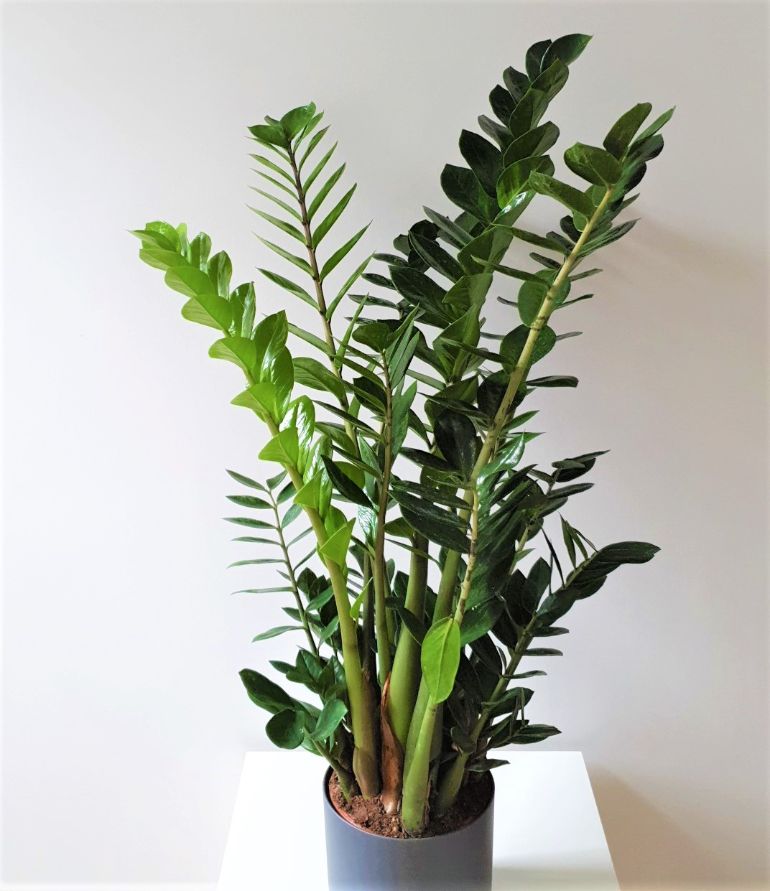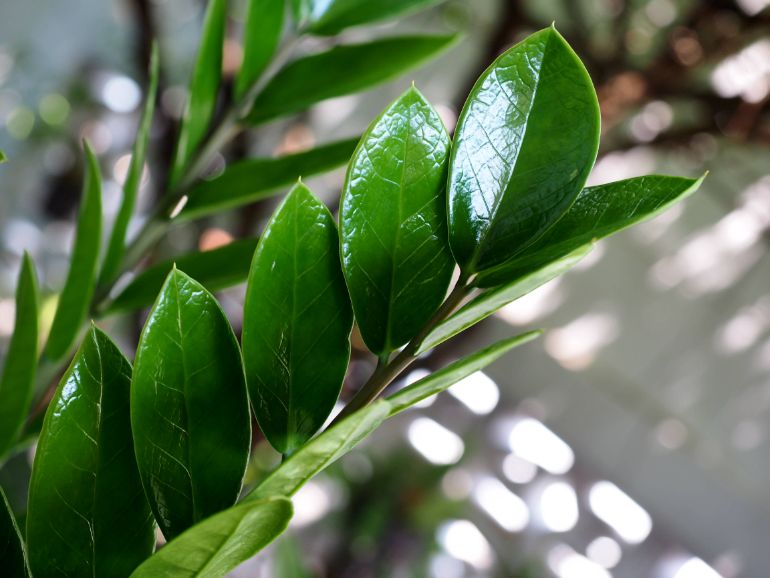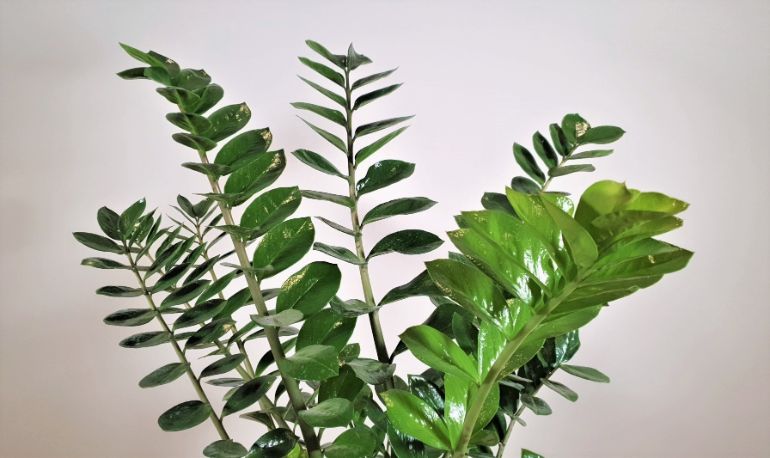ZZ plants are hugely popular houseplants, with stunning, glossy leaves, and interesting upright stems. They are renowned for being tolerant of neglect, easy to care for, and they also grow quite quickly and can become large, impressive plants. This article covers all you need to know about ZZ plant growth rate, size, and how to make yours grow to its full potential.
Most ZZ plants produce 1-3 new stems every few months during the growing season. New stems grow 6-12 inches per month and can reach 3 to 5 feet tall within one growing season. ZZ plants spread horizontally by about an inch per year, but they rarely reach more than 2 feet in diameter.
How Fast Do ZZ Plants Grow?
ZZ plants (Zamioculcas zamiifolia) produce new shoots that grow upward at a rate of up to 6-12 inches (15-30 cm) every month. Their final height can be up to 5 feet tall, depending on whether they are being grown in ideal conditions. They typically grow 6-8 new stems in a single growing season. ZZ plants tend to grow strongly from early spring, through the summer, but slow their growth as the year progresses, and largely stop growing in winter.
If your ZZ plant is producing new shoots it is a good indication that it is happy with the current care it is getting, so if you haven’t seen any growth for a while, it is worth checking to make sure your plant is getting all it needs.
ZZ plants grow from an underground rhizome, which is a modified stem that grows under the soil. New stems grow upward and new roots grow downward from this rhizome, and the rhizome spreads slowly over time.
New stems tend to grow very close together, so even a plant that is quite rootbound can still squeeze new stems up from between the existing foliage.
What Size Are ZZ Plants?
ZZ plants come in a range of sizes. An average-sized plant is often about 1-2 feet (30-61 cm) tall and sold in a 6-8 inch pot. The smallest ZZ plants can be as little as 6-8 inches high with only 1-2 stems and are often sold in 4 inch (10cm) pots. Larger plants can reach 3-5 feet in height and can easily fill an 8-12 inch pot.
Here are some of the key statistics of my large ZZ plant, pictured below. The range indicates the smallest and largest dimensions for my plant.
- Stem height: 3-4 feet (91-122 cm)
- Leaf length: 3-5 inches (7.6-12.7 cm)
- Leaf width: 2-3 inches (5-7.6 cm)
- Stem width: 1-2 inches (2.5-5 cm)
- Pot diameter: 8 inches (20.3 cm)

How Long Does A ZZ Plant Take To Grow?
It takes 3-5 years to grow a ZZ plant from a 1-2 stem plant into a fully grown plant. They usually grow 6-8 new stems per year and spread outwards by about an inch or so in diameter per year. ZZ plant growth rate depends greatly on whether they are given enough light, water, and nutrients, and whether they experience any problems with their care.
What Is The ZZ Plant Growing Season?
The ZZ plant growing season is largely dictated by lighting conditions. In temperate climates, they will typically start growing in early spring and continue to grow until mid-autumn. In tropical climates, ZZ plants will continue to grow all year round.
The first sign of the start of a new growing season is normally a new shoot emerging from the rhizome beneath the soil.
How To Make A ZZ Plant Grow Faster
You can make your ZZ plant grow faster by increasing light, ensuring temperatures are at the upper end of the desired range, avoiding under or overwatering, and providing sufficient nutrients for the plant. Avoiding plant stressors such as low humidity, drafts, pests, and disease will also ensure the growth rate of your ZZ plant is maximized.
The next section will run through a few key points to help your ZZ plant grow as quickly as possible.
Adequate light
ZZ plants have a reputation for being low-light plants, but this is only partly true. Whilst ZZ plants can tolerate low light conditions for a prolonged period of time, they will not produce new growth or thrive without adequate lighting.
ZZ plants do best in bright, indirect lighting, although they can tolerate 1-2 hours of direct sunlight in the early morning or late afternoon.
Lighting changes from room to room and drops dramatically as you move a plant further from a window. It also changes depending on the weather and season outside.
I like to use a light meter app on my phone to give me an idea of whether I should move my ZZ plant to a position that is more or less bright. You can download a light meter app from the Google Play or Apple store for your smartphone.
Read this article to get a better idea of the light requirements for your ZZ plant and how to adjust lighting to ensure optimal growth.
Watering ZZ Plants For Best Growth
Whilst ZZ plants have a reputation for tolerating drought, they tend to grow slower, and produce smaller stems and leaves in water-deficient conditions.
Don’t overdo the watering either, as ZZ plants are reasonably prone to root rot, which will stop all growth in its tracks and can lead to your plant dying. Water your ZZ plant thoroughly once the top half of the soil feels dry, and make sure to let the pot drain well before placing your plant back in its normal spot.
If you’ve had issues with overwatering or underwatering houseplants in the past, read this article to learn exactly when to water your houseplants.
Fertilizing ZZ Plants To Maximize Growth
ZZ plants grow faster when they are given sufficient nutrients to meet their needs. Whether you add compost when potting your plant, or use fertilizer every few months, this can have a big impact on the growth rate.
Just be careful though, as excess fertilizer can damage the roots and actually slow down or stop growth. I tend to use supplemental water-soluble synthetic fertilizer every two months during the growing season, made up at half the recommended concentration.
The options for fertilizing houseplants can seem a bit overwhelming. I’ve written a guide to fertilizing houseplants explains all you need to know.
Why Is My ZZ Plant Not Growing?
ZZ plants stop growing when conditions are inadequate to produce new growth or the plant is stressed by poor care conditions. Inadequate lighting, overwatering, and underwatering are the most common causes of reduced ZZ plant growth rate.
If your ZZ plant stops growing and you do not think lighting or watering are causing a problem, it is important to check carefully for other problems that may be impacting growth.
- Make sure your plant is not rootbound – Once the roots of your ZZ plant have filled the pot, it is increasingly difficult for your plant to produce new growth. If you see roots appearing from the drainage holes, consider repotting in a slightly larger pot.
- Check your plant carefully for any signs of pests or disease – treat any pests or disease problems immediately. Make sure to isolate your plant from any others if you do detect any pest or disease problems.
- Ensure your ZZ plant is not being exposed to temperature stress – ZZ plants will be more than happy in temperatures of 55-85°F (13-29°C), but will start to struggle when kept in temperatures outside this range. Hot or cold drafts, such as from drafty windows, air conditioning vents, or heating appliances can cause problems.

Are ZZ Plants Easy To Grow?
ZZ plants are easy to grow and are quite tolerant of imperfect growing conditions. The most important things to keep your ZZ plant healthy are to provide good lighting and to avoid overwatering. Whilst imperfect growing conditions will impact your ZZ plant’s growth rate, they are much less fussy than some other houseplants.
How To Make A ZZ Plant Bushy
The best way to make a ZZ plant bushy is to provide plenty of light and to meet its basic care conditions. Your ZZ plant will become bushy by producing lots of new stems, and providing good conditions will maximize the number and size of these stems.
A stressed or unhappy ZZ plant can drop leaves, making it appear less bushy, so this is another reason why good care is important if you want to grow a full and healthy ZZ plant.
ZZ Plant New Growth Dying
If the new growth of your ZZ plant appears to be dying, the most likely cause is overwatering. Overwatering causes yellowing of the lower leaves and brown tips on new growth. If overwatering is not the issue, it is highly likely that your plant is experiencing another form of stress.
Look carefully at the plant for other clues, and consider the conditions the plant has experienced recently, as these are likely to point to the cause of the problem.
Last Word
ZZ plants are available in a range of sizes, and it may be best to purchase a plant appropriate for the location you plan to place it. Small specimens look great on tables and windowsills, while larger specimens make fantastic floor plants.
If you want to grow a large plant quickly, focus on providing good care and avoid the common sources of stress to maximize your ZZ plant growth rate. If you’d like to read more about growing beautiful, healthy houseplants, check out some of the following articles.
- Why Do ZZ Plant Stalks Fall Over? (And How To Fix Them)
- Why Do ZZ Plants Get Yellow Leaves?
- How To Water ZZ Plants (A Simple Step By Step Guide)
- Check Out My Book, “Houseplants Made Easy”

